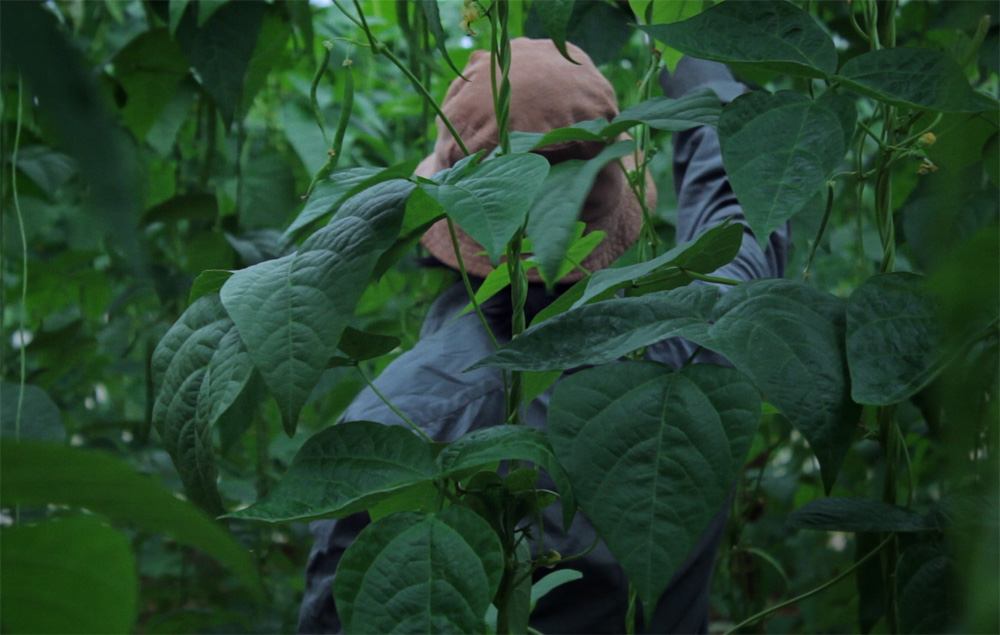There’s only the briefest bits of explicit information provided in “The Plastic House,” but director Allison Chhorn knows how to stretch it out into an all-encompassing experience, imagining one’s parents dying and being left with tending to their greenhouse. Chhorn, the daughter of Cambodian immigrants who have made their living farming in Adelaide, juxtaposes the notion that everything around her continues to grow after one’s parents have passed, reconciling the responsibility of taking care of what lives on while death leaves no one to take care of her.
Though the scenario is one Chhorn has yet to experience herself in real life, she brings it to the screen vividly in her transfixing 45-minute film, currently playing virtually at the New York Film Festival, in which the seasons change, making themselves known in the intensity of inclement weather, but leave no trace as far as the passage of time is concerned. The filmmaker makes her own presence equally elusive, though she put herself through a similarly isolating process behind the scenes as she goes through on camera, capturing restless nights of sleep and days of worrying whether the tarp over the greenhouse is going to hold when a tear threatens to deepen with each passing hour, letting each image and sound that she recorded by herself meticulously build toward the overwhelming but satisfying sensation of coming to terms with such a devastating loss.
One of the real discoveries of this year’s festival, the film’s evocation of bereavement is tempered by the exciting introduction of a filmmaker who is able to channel the curiosity that comes with the unknowns of grief as much as the fear inherent in it, and as “The Plastic House” is now available to see virtually in the U.S. through October 11th, Chhorn graciously answered a few questions about she went about grabbing hold of such a slippery feeling, the solitary work that the film required and letting it loose in the world.
How did this come about for you?
It was really natural because at the time I was working on my farm and also just started getting into filmmaking. I actually studied visual arts when I went to university, and over there, I got to explore different mediums like painting, photography, sculpture, and I eventually came to film and realized it combines all these art forms and it was like the perfect medium for me, so when I heard a lot of stories about people passing away, I was just imagining what it would be like for for the people who had to deal with all this grief while working in the greenhouse.
The images are so striking – were there any that were foundational for you in describing this experience?
On a different project, it would be a lot harder to visualize something if you’re not familiar with it whereas in my case, I was totally immersed in that space, living there every day, so it was really easy for me to imagine the scenes in my head and to see the images. I think the most important image for me is this kind of covering or an abstract figure covered by this plastic, which is a similar image is created through fog as well. I found that particularly strong, especially when I encountered that accidentally when I was filming my dad when he’s fixing the roof. You can see his shadow brushing up against the plastic while I’m inside.
You also keep coming back to this rustling around in bed, which conveys a feeling that would be difficult to articulate otherwise visually. Did that come to you immediately?
That’s also definitely rooted in my personal experience. I feel like it has a lot to do with sound and your hypersensitivity when you’re just thinking about so many things at night. All these sounds for me create the kind of anxious mood and the atmosphere. Because the film has very little dialogue, I wanted all the other sounds, the ambient sounds, the environmental sounds to have more of a presence and to fill the lack of dialogue.
There are a few recordings of your family interspersed throughout the film. Did you know what role those would play from the start?
No, that actually came in the editing. Yeah, there’s lo-fi recordings of my parents that act as memory jump cuts, and I just found that a very obvious medium to use a lo-fi camcorder to juxtapose [with] the other crisp images.
When you film this essentially by yourself, is there someone you can lean on for a perspective outside your own?
The one person I can think about and thank is my producer who, without him, the film would have just been kept on my hard drive and not been shown publicly. Showing it to a close friend who knows how to market the film and distribute it and can really give it a festival life is the most important thing for an independent filmmaker for me.
What’s it been like bringing this out into the world? I know you were fortunate enough to screen it publicly in a theater before the pandemic hit.
It’s been a surreal experience, especially through this pandemic, but it’s definitely been very informative and has given me access to like other filmmakers and other platforms and just the scope of films that are being made like this. It’s very easy to make films in isolation, but once you get connected to other filmmakers, it’s eye-opening. We only had one theatrical screening before the pandemic and it was a nice small screening in my local hometown, but having it screened internationally at various film festivals with a lot of experimental [filmmakers] pushing boundaries and having really kind of art-house audiences see it, they’ve just been able to describe it in ways that I’ve never thought about and can relate to the loneliness of it. After making this film and seeing other people’s interpretation of it, I’ve realized it has a lot of layers and meanings and people are reading into it a lot more than I originally intended. It’s been really interesting.
“The Plastic House” is screening virtually at the New York Film Festival through October 11th.




